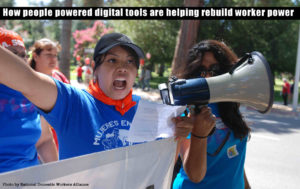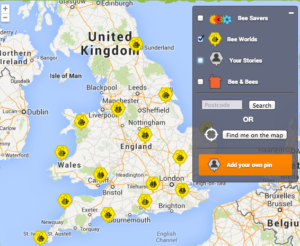This is a guest post by our colleague Darren Barefoot. It’s adapted from The Noble Arsonist, a free e-book about NGO communications.
To stand out online, you’ve got to be remarkable.
In 2013, that seems like a truism, but too few campaigners take it to heart. Stuff that succeeds on the web does so because it is literally remarkable—worthy of being remarked upon. Whether it’s a brilliant marketing campaign for vitamin water or yet another hilarious cat video, nobody shares the ordinary.
It’s an exceptionally noisy marketplace. NGOs compete with each other, and every other product, service, campaign and idea in the world for attention. We have smaller budgets than vitamin water vendors, but fortunately it’s possible to devise exceptional online campaigns without spending a million dollars.
If you’re an NGO with a story to tell, where do you start? There are plenty of consultants out there who want to sell you The Processtm, which will guarantee you extraordinary viral growth and exposure to engaged, deep-pocketed new audiences. Don’t believe them.
Web marketing is, at best, 12 or 15 years old. We are all still throwing spaghetti at the wall to see if it sticks. When it comes to creating a remarkable campaign, we need to humbly accept the reality that, in Seth Godin’s words, “safe is risky and risky is safe.” We need to see our work as a marathon, not a sprint, and know that this time we may only hit a single, but the next time we can hit a homerun.
With those caveats in mind, here are seven tricks we rely on when developing exceptional campaigns. Around our office, we call these “remarkables.”
Make more of what the web loves
At the moment, the web loves animated GIFs, supercuts and Macklemore. Last year, it loved Instagram filters, zombies and Ryan Gosling. The web should be a rich source of inspiration for building outstanding campaigns. If, for example, millions of web users liked a particular advertising campaign, can you make a video that emulates, riffs on or satirizes that ad? That’s what students at Brigham Young University did. They created a charming, note-perfect take-off of the wildly popular Old Spice YouTube ads. Their student-made ad for a university library has gathered more than three million views:
As long as you acknowledge your influences and antecedents, don’t be afraid to copy old ideas. That’s what we did with Drawn to the Wild, a collaborative drawing project that was based on The Johnny Cash Project. We always cited the The Johnny Cash Project as inspiration in our communications, but felt comfortable in borrowing the idea. There’s another reason to take this approach—the original acts as a kind of social proof for your campaign. If it was popular once, then your variation on the idea can be popular, too.
And you can always explore what the web used to love, like this terrific retro site by Norwegian Church Aid.
How could your organization make a remarkable campaign that’s inspired by these beautiful wind visualizations, Tiffany’s What Makes Love True Instagram project or Pitchfork’s cool presentation of the top 200 albums of all time?
Adopt a new technology really early
Stop reading and think about how your organization could be using Vine—Twitter’s new six-second video app—to spread your message or anchor a campaign.
Each time a new technology starts to gain momentum, there’s an opportunity to get in early and use it to successfully tell your story. Not only do you enjoy a first-mover advantage with scarce competition, but you can build significant credibility by teaching your community about it. Back when it still mattered, if you taught somebody about RSS, then yours was the first blog they subscribed to.
Also, novelty sells. American Apparel probably didn’t make much money from selling virtual t-shirts in Second Life, but they enjoyed extensive media coverage as one of the first big corporations to sell in a virtual world.
Explore extremes
I’m the first to emphasize the importance of measurement and testing in NGO communications. However, we can become slaves to numbers—we have a list that is this big, we’re trying to maintain funding at this level and so forth.
Instead, consider radically changing the scope of your activity. Ask yourself questions like, “what if instead of 100 photos of our offline action, we collected 100,000? What could we do with those?” The NAMES Project Foundation asked the question, “what do we do with our AIDS quilt, now that it weighs 53 tons and is too big to display anywhere?” They put it online, in what is an extraordinary expression of the quilt’s scope and impact.
Make them laugh, make them laugh
You know what’s not implicitly funny? Railway safety. And yet, Metro Trains Melbourne created a videoon that topic that’s received nearly 40 million views.
And speaking of what the web loves, they astutely posted a series of cute animated GIFs from the video on Tumblr.
Being funny is particularly scary, because humour is both subtle and subjective. The history of marketing is full of failed campaigns that just missed the mark with their humour. The Motrin Moms campaign is a classic example of this, where a relatively small adjustment in tone might have saved the company the wrath of mommy bloggers across the nation.
Put a map on it
Maps are the secret weapon of the web. In 2013, it’s surprising how few organizations have exhausted the opportunities that maps enable. Maps are, obviously, a great way of illustrating topical information—consider the Lord’s Resistance Army Crisis Tracker. But they’re also an excellent, low threshold means of engaging with new users. People inexplicably love to put themselves on a map.
Enable play
As NGOs, we tend to see our role as informing, educating and inciting our constituencies. But we should also seek to entertain, amuse and delight our audiences. How can you enable supporters (and potential supporters) to have a playful or whimsical experience in one of your campaigns?
Global Zero has an unfun cause. They’re an international movement for the elimination of all nuclear weapons worldwide. We worked with them in building Survive the Blast, a kind of Facebook-powered version of whack-a-mole, where you choose which of your friends you would save from a nuclear blast. Not only did the campaign amuse users who frantically clicked on their friends’ profile photos to save them, but it also personalized the sometimes-abstract issue of nuclear disarmament.
There are, of course, dozens of tricks like this to help us think laterally and devise original campaign ideas. I’ll leave you with one of my strangest techniques for creative thinking: I page through a few cards of Brian Eno’s curious and wonderful Oblique Strategies. You can give it a try yourself, if you dare.
Categories:
tech, tools and tactics



